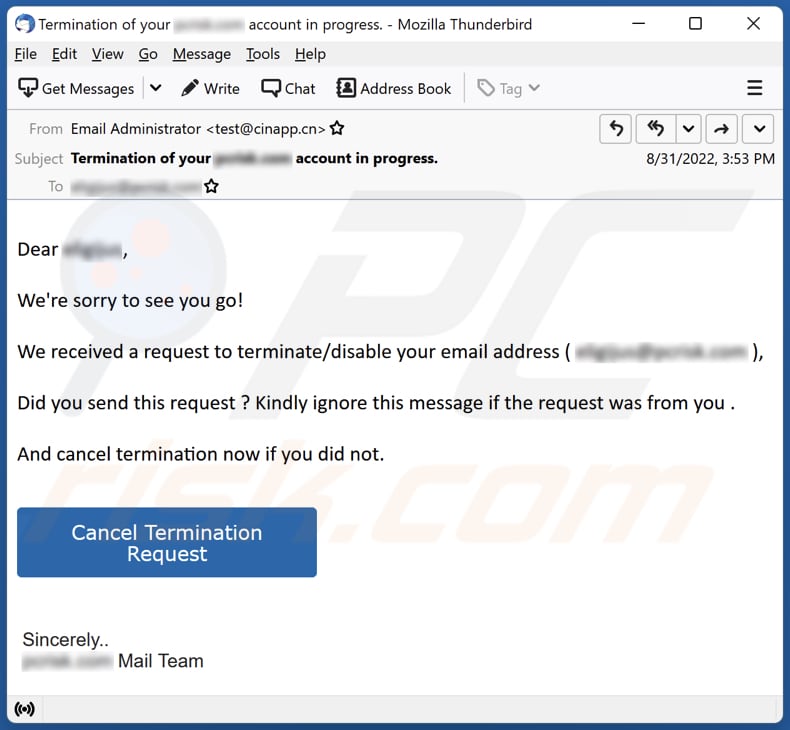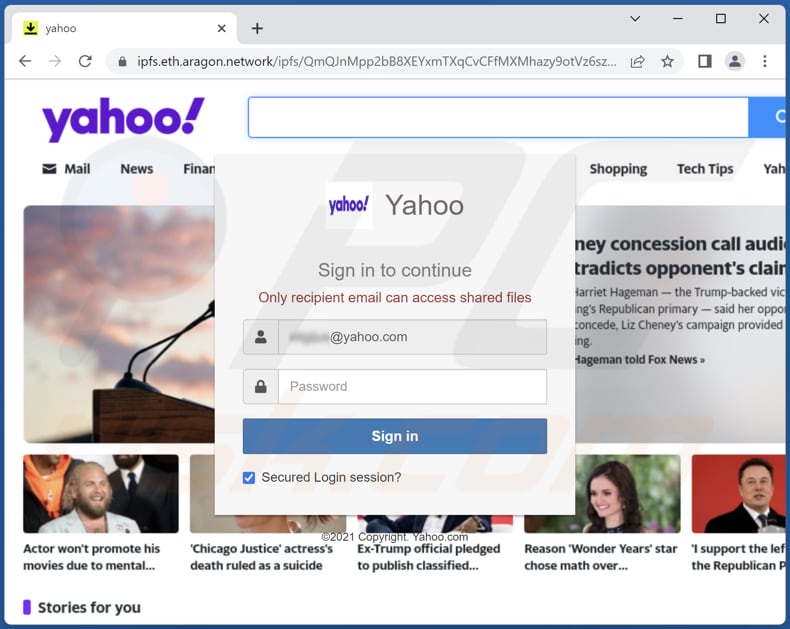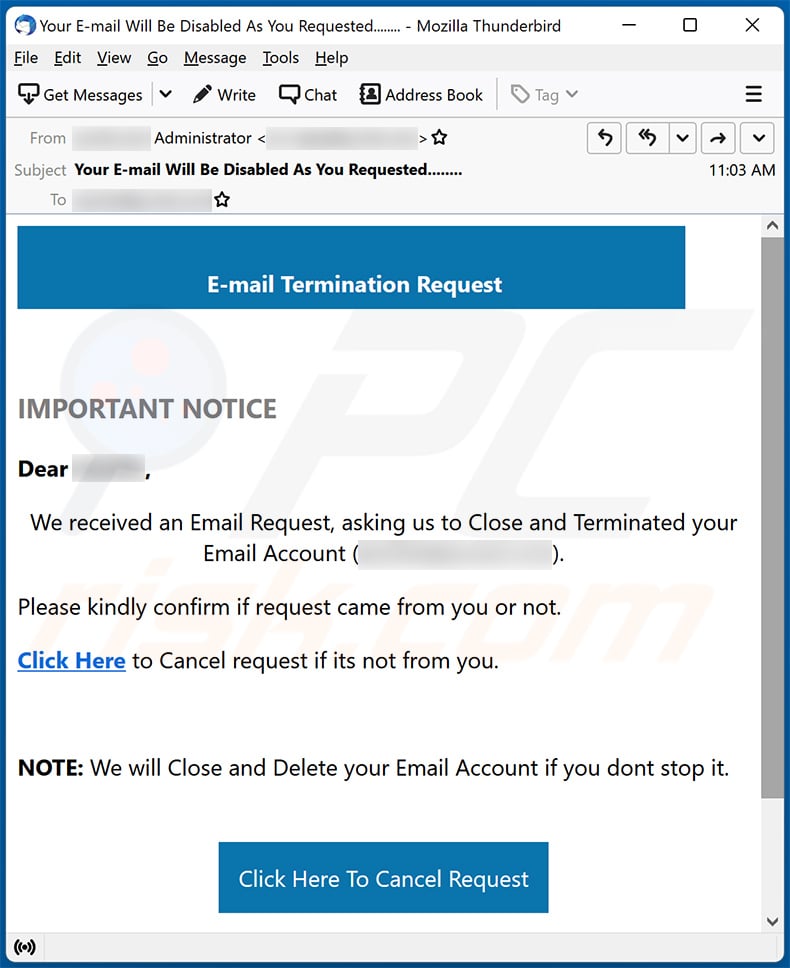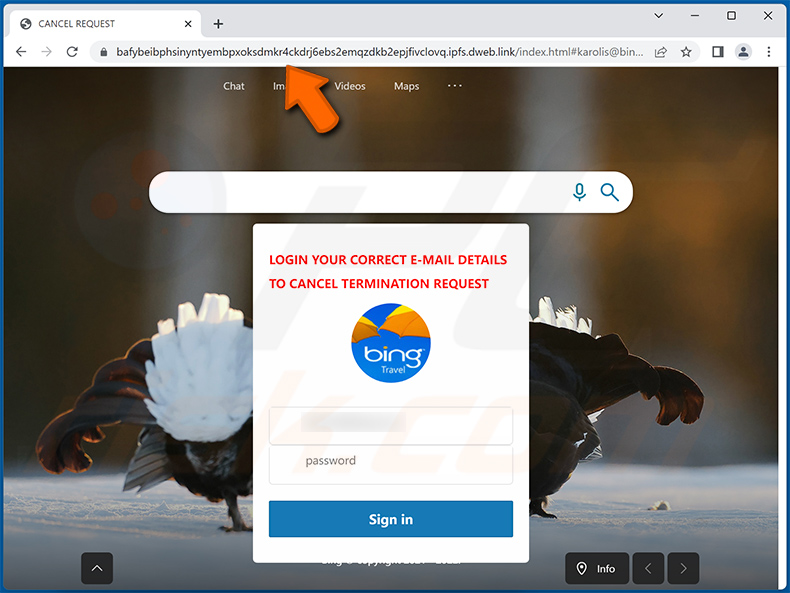How to spot phishing emails like "Request To Terminate/Disable Your Email"
Phishing/ScamAlso Known As: Request To Terminate/Disable Your Email phishing campaign
Get free scan and check if your device is infected.
Remove it nowTo use full-featured product, you have to purchase a license for Combo Cleaner. Seven days free trial available. Combo Cleaner is owned and operated by RCS LT, the parent company of PCRisk.com.
What is "Request To Terminate/Disable Your Email"?
After inspecting this email, we learned that it is sent by scammers who aim to trick unsuspecting recipients into providing personal information. The scammers behind this email are pretending to be email service providers. They use a phishing website to extract information from recipients.

More about the "Request To Terminate/Disable Your Email" scam
Scammers claim that termination of the specified email account is in progress. They imply that request to terminate the account has been submitted by the recipient. Their goal is to trick the recipient into believing that this request was actually submitted and can be cancelled.
The email contains the "Cancel Termination Request" button/hyperlink. Clicking that button opens a deceptive page whose design depends on the recipient's email address. For example, if the recipient uses Yahoo Mail, then the link in the email opens a page masquerading as the official Yahoo page.
The purpose of this email scam is to trick the recipient into providing the password used to access the email account. Typically, scammers use accessed email accounts to obtain more sensitive information and attempt to access other accounts with the same password. Also, they can sell obtained information to third parties.
| Name | Request To Terminate/Disable Your Email Scam |
| Threat Type | Phishing, Scam, Social Engineering, Fraud |
| Fake Claim | Email service provided received request to disable account |
| Disguise | Letter from email service provider |
| Symptoms | Unauthorized online purchases, changed online account passwords, identity theft, illegal access of the computer. |
| Distribution methods | Deceptive emails |
| Damage | Loss of sensitive private information, monetary loss, identity theft. |
| Malware Removal (Windows) |
To eliminate possible malware infections, scan your computer with legitimate antivirus software. Our security researchers recommend using Combo Cleaner. Download Combo CleanerTo use full-featured product, you have to purchase a license for Combo Cleaner. 7 days free trial available. Combo Cleaner is owned and operated by RCS LT, the parent company of PCRisk.com. |
Similar scams in general
Scammers behind phishing emails usually pretend to be legitimate companies, organizations, or other entities. They request personal/sensitive information directly or instruct recipients to enter requested details on the provided website. Usually, they aim to extract credit card details, passwords, ID card information, and other personal details.
Examples of similar emails are "Password Is Scheduled To Expire Email Scam", "DHL Express - CONFIDENTIALITY NOTICE Email Scam", and "Norton Order Confirmation Email Scam". Threat actors use email not only to obtain information but also to deliver malware.
How do spam campaigns infect computers?
Most cybercriminals use Microsoft Office or PDF documents, archive files like ZIP, RAR, executable files, or JavaScript files to distribute malware. They attach these files to their emails or send websites designed to download those files. Users infect computers after they execute downloaded malware by themselves.
Not all files infect computers right after opening them. For instance, malicious MS Office documents cannot infect computers until macros commands are enabled. Archive files cannot infect computers, too - users cause computer infections by opening files extracted from archive files.
How to avoid installation of malware?
Do not open files/attachments and links sent from unknown email addresses, especially when emails are irrelevant. Avoid using unofficial websites and other unreliable sources as sources for downloading files and software. Download them from official pages and stores.
Update and activate the installed software (and the operating system) with tools its official developer provides. Keep software up to date. Run antivirus scans regularly. Use reputable security software for computer protection.
If you've already opened malicious attachments, we recommend running a scan with Combo Cleaner Antivirus for Windows to automatically eliminate infiltrated malware.
Text presented in the "Request To Terminate/Disable Your Email" email letter:
Subject: Termination of your ******** account in progress.
Dear ********,We're sorry to see you go!
We received a request to terminate/disable your email address ( ******** ),
Did you send this request ? Kindly ignore this message if the request was from you .
And cancel termination now if you did not.
Cancel Termination Request
Sincerely..
******** Mail Team
Screenshot of the fake Yahoo website:

Another example of an email from this spam campaign:

Text presented within:
Subject: Your E-mail Will Be Disabled As You Requested........
E-mail Termination Request
IMPORTANT NOTICE
Dear ********,
We received an Email Request, asking us to Close and Terminated your Email Account (********).
Please kindly confirm if request came from you or not.
Click Here to Cancel request if its not from you.
NOTE: We will Close and Delete your Email Account if you dont stop it.
Click Here To Cancel RequestE-mail Administrator
© 2022 Corporation. All rights reserved.
Screenshot of the promoted phishing site designed to imitate user's email provider:

Instant automatic malware removal:
Manual threat removal might be a lengthy and complicated process that requires advanced IT skills. Combo Cleaner is a professional automatic malware removal tool that is recommended to get rid of malware. Download it by clicking the button below:
DOWNLOAD Combo CleanerBy downloading any software listed on this website you agree to our Privacy Policy and Terms of Use. To use full-featured product, you have to purchase a license for Combo Cleaner. 7 days free trial available. Combo Cleaner is owned and operated by RCS LT, the parent company of PCRisk.com.
Quick menu:
- What is Request To Terminate/Disable Your Email phishing campaign?
- Types of malicious emails.
- How to spot a malicious email?
- What to do if you fell for an email scam?
Types of malicious emails:
![]() Phishing Emails
Phishing Emails
Most commonly, cybercriminals use deceptive emails to trick Internet users into giving away their sensitive private information, for example, login information for various online services, email accounts, or online banking information.
Such attacks are called phishing. In a phishing attack, cybercriminals usually send an email message with some popular service logo (for example, Microsoft, DHL, Amazon, Netflix), create urgency (wrong shipping address, expired password, etc.), and place a link which they hope their potential victims will click on.
After clicking the link presented in such email message, victims are redirected to a fake website that looks identical or extremely similar to the original one. Victims are then asked to enter their password, credit card details, or some other information that gets stolen by cybercriminals.
![]() Emails with Malicious Attachments
Emails with Malicious Attachments
Another popular attack vector is email spam with malicious attachments that infect users' computers with malware. Malicious attachments usually carry trojans that are capable of stealing passwords, banking information, and other sensitive information.
In such attacks, cybercriminals' main goal is to trick their potential victims into opening an infected email attachment. To achieve this goal, email messages usually talk about recently received invoices, faxes, or voice messages.
If a potential victim falls for the lure and opens the attachment, their computers get infected, and cybercriminals can collect a lot of sensitive information.
While it's a more complicated method to steal personal information (spam filters and antivirus programs usually detect such attempts), if successful, cybercriminals can get a much wider array of data and can collect information for a long period of time.
![]() Sextortion Emails
Sextortion Emails
This is a type of phishing. In this case, users receive an email claiming that a cybercriminal could access the webcam of the potential victim and has a video recording of one's masturbation.
To get rid of the video, victims are asked to pay a ransom (usually using Bitcoin or another cryptocurrency). Nevertheless, all of these claims are false - users who receive such emails should ignore and delete them.
How to spot a malicious email?
While cyber criminals try to make their lure emails look trustworthy, here are some things that you should look for when trying to spot a phishing email:
- Check the sender's ("from") email address: Hover your mouse over the "from" address and check if it's legitimate. For example, if you received an email from Microsoft, be sure to check if the email address is @microsoft.com and not something suspicious like @m1crosoft.com, @microsfot.com, @account-security-noreply.com, etc.
- Check for generic greetings: If the greeting in the email is "Dear user", "Dear @youremail.com", "Dear valued customer", this should raise suspiciousness. Most commonly, companies call you by your name. Lack of this information could signal a phishing attempt.
- Check the links in the email: Hover your mouse over the link presented in the email, if the link that appears seems suspicious, don't click it. For example, if you received an email from Microsoft and the link in the email shows that it will go to firebasestorage.googleapis.com/v0... you shouldn't trust it. It's best not to click any links in the emails but to visit the company website that sent you the email in the first place.
- Don't blindly trust email attachments: Most commonly, legitimate companies will ask you to log in to their website and to view any documents there; if you received an email with an attachment, it's a good idea to scan it with an antivirus application. Infected email attachments are a common attack vector used by cybercriminals.
To minimise the risk of opening phishing and malicious emails we recommend using Combo Cleaner Antivirus for Windows.
Example of a spam email:

What to do if you fell for an email scam?
- If you clicked on a link in a phishing email and entered your password - be sure to change your password as soon as possible. Usually, cybercriminals collect stolen credentials and then sell them to other groups that use them for malicious purposes. If you change your password in a timely manner, there's a chance that criminals won't have enough time to do any damage.
- If you entered your credit card information - contact your bank as soon as possible and explain the situation. There's a good chance that you will need to cancel your compromised credit card and get a new one.
- If you see any signs of identity theft - you should immediately contact the Federal Trade Commission. This institution will collect information about your situation and create a personal recovery plan.
- If you opened a malicious attachment - your computer is probably infected, you should scan it with a reputable antivirus application. For this purpose, we recommend using Combo Cleaner Antivirus for Windows.
- Help other Internet users - report phishing emails to Anti-Phishing Working Group, FBI’s Internet Crime Complaint Center, National Fraud Information Center and U.S. Department of Justice.
Frequently Asked Questions (FAQ)
Why did I receive this email?
This email is not personal (scammers sent it to all or most addresses they have).
I have provided my personal information when tricked by this email, what should I do?
If you provided your password on a fake Yahoo (or other email service provider) page, change other passwords as soon as possible and contact the email service provider.
I have downloaded and opened a malicious file attached to an email, is my computer infected?
If you have opened an executable file, your computer can be already infected. Malicious Microsoft Office documents, archive files, and certain other files do not infect computers until additional steps are performed.
I have read the email but didn't open the attachment, is my computer infected?
It is safe to open emails that contain malicious attachments or links. Emails cannot infect computers unless received files or links are opened.
Will Combo Cleaner remove malware infections that were present in email attachment?
Yes, Combo Cleaner can detect and eliminate almost all known malware. Computers infected with high-end malware must be scanned fully (using a full scan). Otherwise, antivirus software may not be able to detect malware.
Share:

Tomas Meskauskas
Expert security researcher, professional malware analyst
I am passionate about computer security and technology. I have an experience of over 10 years working in various companies related to computer technical issue solving and Internet security. I have been working as an author and editor for pcrisk.com since 2010. Follow me on Twitter and LinkedIn to stay informed about the latest online security threats.
PCrisk security portal is brought by a company RCS LT.
Joined forces of security researchers help educate computer users about the latest online security threats. More information about the company RCS LT.
Our malware removal guides are free. However, if you want to support us you can send us a donation.
DonatePCrisk security portal is brought by a company RCS LT.
Joined forces of security researchers help educate computer users about the latest online security threats. More information about the company RCS LT.
Our malware removal guides are free. However, if you want to support us you can send us a donation.
Donate
▼ Show Discussion